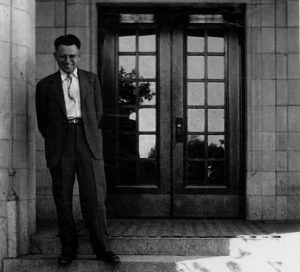Science as Vocation and Life
Posted by admin on

By Dimitry Zakharov
Gerhard Herzberg was a man of science. His life revolved around his office, where he spent countless hours, often working six days a week going over spectrograms, interpreting and writing results, and familiarizing himself with the latest research in his own field and quantum physics in general.
Spectroscopy and the scientists involved in this field were his first family. In his short 1985 memoir, published in the Annual Review of Physical Chemistry, Herzberg recollects the moment in 1929 when he married Luise Oettinger, who co-authored several papers with him, and mentions the birth of his two children, Paul and Agnes, when they lived in Saskatoon.[i] The focus of this memoir, however, was spectroscopic research and the people who contributed to this discipline – scientists like Alex Douglas and Walter Heitler, and the affirmation of their work by Sir Chandrasekhara Venkata Raman, whom Herzberg met in England. Despite conventional ideas about individual genius, which still persists in the form of breakthroughs attributed to the ideas of a single person, Herzberg’s work attests to the importance of the scientific community and the collaborators who often play a far larger role than they are given credit for.
Science as a Community
Gerhard Herzberg’s intellectual history is a complicated subject. He was trained as a theoretical physicist at Darmstadt and then Göttingen, the best physics university of the time. Perhaps only the Cambridge system with its Wrangler system could have matched it in terms of prestige and sheer physico-mathematical importance. In the Cambridge mathematics program, the first place Senior Wrangler exemplified an achievement of the university itself, and this classification system went down to the lowest final passing grade of the year, accompanied by the dubious title of Wet Spoon.[ii] As historian of science Iwan Rhys Morus has argued, English and German universities of the 19th century had different models of education. While English universities favored mathematical and empirical science, German universities encouraged a Buildung model, favoring a holistic or balanced approach that encompassed scientific disciplines, as well as the arts, history, philosophy, literature, and music.
This model produced some of the best scientists of the time and didn’t ignore creating a balanced individual.[iii] Morus argues that the German educational model produced more theoretically minded scientists than their English counterparts. Herzberg, a product of this system, specialized in the sciences, but was also well versed in music and philosophy.[iv] What’s more, he formed scientific communities wherever he went. Herzberg was a brilliant experimentalist, an equally brilliant theoretician, and he also possessed an aura of charisma that gathered other great minds around him wherever he went.
Gerhard Herzberg’s spectroscopy research focused on establishing fundamental knowledge about structure and geometry of atoms and molecules and continued the work of the first generation of atomic physics and spectroscopy pioneered by people like Kirchhoff, Bunsen, Lenard, Planck, and Herzberg’s own post-doctoral supervisor, James Franck. Herzberg’s own work emerged from his collaboration with numerous people, including several post-doctoral fellows and laboratory assistants who worked at the National Research Council of Canada (NRC) in the 1950s and 1960s. His research was also informed by the exchange of knowledge between Herzberg’s far-flung network of physicist and spectroscopist colleagues in Canada, the United States, England, and West Germany.
In his biography, Boris Stoicheff notes Herzberg’s charisma, which helped him bring people together. He strove to facilitate community and scientific dialogue amongst his assistants during his time at the University of Saskatchewan and then at the NRC. In many ways, Herzberg was trying to continue the scientific culture and conversation he first encountered when he was a student in Germany. The weekly “Physics Colloquia” in the Theoretical Physics Department at the University of Gottingen brought together some of the greatest minds at the time, among them James Franck, Max Born, Wolfgang Pauli, Werner Heisenberg, Friedrich Hund, Walter Heitler, and Robert Oppenheimer (who was there as a Postdoctoral Fellow from America). Franck (1882-1964), one of the directors of the Theoretical Physics Section in charge of the Mathematics Division, had borrowed the idea for a weekly colloquium from the University of Berlin, where, as a student, he attended weekly lectures by great physicists like Max Planck and Albert Einstein.[v]
In 1929, Herzberg went to Bristol, England, for a one-year postdoctoral fellowship and found the same sort of intellectual life he had enjoyed in Germany. While he understood that the University of Bristol would not be able to match Gottingen or Darmstadt in terms of intellectual firepower, he nevertheless enjoyed the company of scientists like Arthur Tyndall and J. E. Lennard-Jones. While in England, he also met Chandrasekhara Venkata Raman, another important physicist in the field of spectroscopy; he received the 1930 Nobel Prize in Physics for his work on light scattering, known as the Raman effect.
At Bristol, Herzberg discovered another new tradition he carried on for the rest of his life: afternoon tea. The tea break provided an opportunity for Bristol’s spectroscopy laboratory staff to discuss their scientific activities and the latest developments in physics from across the world. Herzberg continued this tradition when he became director of the NRC. At 4 p.m., the NRC scientific staff stopped their work so they could discuss their scientific research over tea.
At the relatively new University of Saskatchewan, he became a central intellectual figure. Postdoctoral fellows like Alex Douglas, who later worked with Herzberg at the NRC, attended Herzberg’s physics lectures. Former U of S president Peter MacKinnon directly linked Herzberg’s presence to several important events, like the development and calibration of Canada’s first cobalt-60 machine. Similarly, the Canadian Light Source Synchrotron, which was constructed at U of S in 1999, owes its existence to the legacy of spectroscopic research and physics education Herzberg create during his time there.[vi]

Dr. Gerhard Herzberg pictured at the University of Saskatchewan. Image courtesy of the University of Saskatchewan Archives.
This is also perhaps why Herzberg left the U of S to take a position at the Yerkes Observatory, at the University of Chicago. There, Herzberg would be able to work with fellow scientists from Germany, including his old mentor and quantum physicist James Franck. Additionally, at U of C, he was in the company of world leaders in physics and astrophysics, like the astronomer Otto Struve, spectroscopist and experimental physicist Robert Mulliken (who won the Nobel Prize in 1966), and the brilliant mathematician Subrahmanyan Chandrasekhar who, at the age of 19, had worked out the star mass limit of a white dwarf (known as the Chandrasekhar limit) while travelling by boat to England in 1929.[vii]
Unfortunately, Herzberg soon found that the Yerkes Observatory was quite far from the main U of C campus, He didn’t drive, and his interactions with Franck or Mulliken were few and far in between. Meanwhile, Struve, the Yerkes director, had to split his time between the Chicago facility and the McDonald Observatory in Texas, where he was also director. Herzberg and Chandrasekhar became close friends and so did their families. They even co-authored several papers in the 1950s. But Herzberg felt isolated from the intellectual community and the spectroscopy community he had cherished at Gottingen.
Additionally, there was very little room for professional advancement. Mulliken’s spectroscopy group at the U of C’s main campus was well established and world-renowned. That meant there was little hope for Herzberg to ever have his own internationally recognized laboratory in Chicago, as he had imagined for himself at Darmstadt, before Hitler and the Nazis came to power.

Portrait of Dr. Gerhard Herzberg (with microscope), c. 1959. Image courtesy of the Dr. Gerhard Herzberg Fond, the National Research Council.
When Herzberg accepted E.W.R. Steacie’s offer to join the NRC, he saw an opportunity to establish the kind of scientific community he’d experienced elsewhere. He could run his own well-funded laboratory with none of teaching or administrative duties that came with a faculty position at a university. (Herzberg did end up taking on those administrative duties when he became the NRC’s director of the physics division after less than a year in his initial role as Principal Research Officer of the Spectroscopy Laboratory.) The NRC offered an opportunity for Herzberg to recruit and train promising young scientists and thereby created what Stoicheff has called, “a temple of science”[viii] in Canada.
Herzberg encouraged the international spectroscopists who had gravitated to the NRC to expand their own professional networks, present their work at conferences, and collaborate with researchers from other institutions. In fact, he and Steacie took care in establishing the NRC’s international reputation. Postdoctoral fellows from many different countries outside of the geopolitical West, including the Soviet Union, Japan, and China, were invited to work at the NRC. Herzberg himself constantly travelled to present at conferences, offering invitations to leading scientists to join him. Chandrasekhar visited the NRC on multiple occasions like the different Physics colloquia that the NRC held continuously until the late 1980s and published several articles with Herzberg.

P. Dirac, T.Y. Wu, and Gerhard Herzberg c.1955. Image courtesy of the Dr. Gerhard Herzberg Fond, the National Research Council.
In 1965, Herzberg convened a conference in honor of Paul Dirac (1933 Nobel Prize in Physics with Erwin Schrodinger). Dirac was one of the mid-20th century’s most recognized mathematicians and physicists. Unfortunately, due to Dirac’s advanced age and declining health, he and his wife were only able to visit Ottawa after the conference, but the event itself still brought together hundreds of scientists from across Canada and the world and served as a great opportunity to demonstrate the work of the bright minds at the NRC.
The Invisible “Techniks”
Herzberg’s name always appeared first on a peer-reviewed journal article, no matter how much he had contributed. In some cases, his contributions were primarily corrections and a final approval. Yet beneath the published names of the authors and co-authors, there was an network of research assistants who enabled the laboratory to function, and can thus be seen as important contributors to the NRC’s output.
Going back centuries, scientists have been supported in their work by assistants, inventors, engineers and other technicians. Their names are sometimes omitted from journal articles and these individuals may not even be recognized by scientific societies.
In Herzberg’s NRC, one such figure was Jack Shoosmith, a senior technician who worked at the King’s College in London before moving to Ottawa in 1952. Shoosmith wasn’t a scientist per se, like the NRC’s other post-doc spectroscopists and physicists, and yet he played an important role in the experimental work of Herzberg’s spectroscopy lab. Indeed, he was credited as a co-author on several journal articles and was acknowledged in every paper involving spectroscopy at the NRC as “instrumental in the experimental part of the work” until his retirement in 1969.
The reason for needing a technician has to do with the technical aspect of the discipline. Spectrographs and other research equipment broke and had to be fixed. They needed to be calibrated and prepared for specific experiments. In some cases, Shoosmith had to design and build devices on the spot. This was the case with the “flash photolysis” technique developed in the late 1940s to study free radicals. Since no such equipment existed anywhere in the world at the time — only one other group in Cambridge was experimenting with a similar process – NRC technicians had to build it from scratch. Shoosmiths’s contribution, like those of other NRC assistants and technicians, proved to be invaluable to the day-to-day operation of the laboratory, and thus in the creation of the experimental knowledge itself.
Today’s science is no different and arguably relies even more on such invisible technicians to keep things working. Good mechanics, able to fix telescopes and spectrographs, are still vital. However, the science of the modern day ubiquitously relies on computers and digital technology. Computers and computational technology now permeate all manner of scientific work, from spectroscopy and physics, to molecular biology and genetics: everything uses computers and increasingly also implements machine learning and neural networks that perform massive amounts of calculations impossible for humans to ever accomplish by hand. Writing and implementing new code, fixing bugs, updating applications, and all manner of other I.T. is crucial for the function of the modern research laboratory, even if a great deal of this work ends up adding to the prestige and profile of the ‘great researcher’ or ‘great scientist’ who lead the laboratory, just as Robert Hooke’s or Jack Shoosmith’s work in the past.
Conclusion
Popular understandings of what science is, and how science works, often obscure the line between science as knowledge and science as the production of knowledge. The word `science’ is often understood as an activity that one undertakes to create truth of the natural world. Yet simultaneously, science is also the goal of that production: to produce scientific knowledge and scientific truths.
Historian of science Stephen Shapin argues that knowledge is not some hidden thing that is uncovered or discovered. Knowledge, he says, is a consensus, a relationship of trust. And the ‘truth’ derived from that knowledge does not come from a single place or from a single person.
“The history of truth.” Shpain argues, “can be a social history because what we know about the world is arrived at, sustained, and recognized through collective action. Against dominant romantic and heroic views, it is argued that no single individual can constitute knowledge: all the individual can do is offer claims, with evidence, arguments, and inducements, to the [scientific] community for its assessment. Knowledge is the result of the community’s evaluations and actions, and it is entrenched through the integration of claims about the world into the community’s institutionalized behavior.”[ix]
In other words, while the idea of the independent genius who discovers scientific truth is enticing, it is also a myth. Science is done by people, not a person. Researchers work in teams, not in isolation. Experiments do not establish truth. Rather, the truths revealed through experiments are the result of a collective of scientists working in a particular area of research and coming to a consensus on their work.

The Spectroscopy group at the NRC. Image courtesy of the Dr. Gerhard Herzberg Fond, the National Research Council.
Finally, science emerges from a relationship of trust among scientists, and also between scientists and the broader public. Gerhard Herzberg exemplified this principle of trust in the creation of knowledge. The integrity and reliability of his scientific work was beyond reproach. He brought an unsurpassed expertise in the still developing field of quantum mechanics.
However, this idea of trust works inversely as well. Herzberg depended on the people around him, and the scientific communities he created. The scientists with whom he worked and those he mentored at the NRC furthered his own name and contributed to his eventual Nobel Prize. His wife, Luise, was one of the most important scientists upon whom Herzberg depended. She contributed both physical and emotional labour to further his career, at the expense of her own.
Neither can we forget the countless research assistants and technicians whose efforts allowed Herzberg’s laboratory to function. In the global and rapidly digitizing present-day world, their work is more important than ever. As the 17th-century English academic Obadiah Walker wrote, “Great persons must necessarily hear and see with other men’s ears and eyes; and whom can they trust so well as their own servants.”
Dimitry Zakharov is a PhD Candidate (ABD) in History at the University of Saskatchewan. Funding for the Herzberg50 Commemoration is provided by the Ministry of Canadian Heritage and the National Research Council of Canada.”
Defining Moments Canada is an online Canadian heritage organization dedicated to commemorating ‘definitional moments’ in our shared history through trans-disciplinary education initiatives. This organization has hosted a number of commemorative projects such as Spanish Flu, VEDay75, Juno75and Insulin100. DMC’s approach is informed through Curatorial Thinking and the SASS framework (Selection, Archiving, Sense-Making and Sharing). This process encourages students to critically examine research material and consider their own “position in time and space” in relation to the narratives they study (Mant, 2020), Moreover, with the onset and continuation of the COVID-19 pandemic, DMC is advocating for the re-conceptualization of education to promote interdisciplinary or “syndemic” thinking.
[i] Herzberg, Gerhard. “Molecular Spectroscopy: A Personal Memoir” Annual Review of Physical Chemistry 36 (1985): 1-36.
[ii] Iwan Rhys Morus, When Physics Became King,
[iii] Morus,
[iv] Iwan Rhys Morus, When Physics became king,
[v] Stoicheff, 44-48.
[vi] MacKinnon, Peter, University Leadership and Public Policy in the Twenty-First Century, (Toronto: University Press, 2014): 111-112.
[vii] Stoicheff, 170.
[viii] Stoicheff, 209.
[ix] Shapin, The Social History of Truth, 6.
—
This post was previously published on ACTIVEHISTORY.CA and licensed under a Creative Commons Attribution-NoDerivatives 4.0 International License.
***
You may also like these posts on The Good Men Project:
 White Fragility: Talking to White People About Racism White Fragility: Talking to White People About Racism |
 Escape the “Act Like a Man” Box Escape the “Act Like a Man” Box |
 Why I Don’t Want to Talk About Race Why I Don’t Want to Talk About Race |
 What We Talk About When We Talk About Men What We Talk About When We Talk About Men |
Join The Good Men Project as a Premium Member today.
All Premium Members get to view The Good Men Project with NO ADS.
A $50 annual membership gives you an all access pass. You can be a part of every call, group, class and community.
A $25 annual membership gives you access to one class, one Social Interest group and our online communities.
A $12 annual membership gives you access to our Friday calls with the publisher, our online community.
Register New Account
Log in if you wish to renew an existing subscription.
Need more info? A complete list of benefits is here.
—
Photo credit: Active History
The post Science as Vocation and Life appeared first on The Good Men Project.
